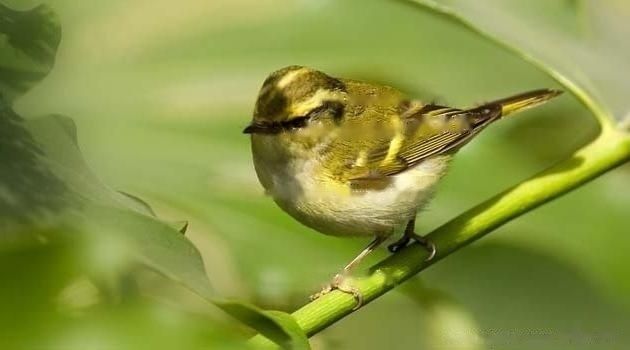The yellow-rumped willow warbler, also known as the Barth's warbler, the lemon warbler, the tree bell, the willow, the mung bean sparrow etc., are classified in the genus Willow warbler in the family. It is a small bird native to Siberia. Most of the birds in my country are migratory birds, mainly distributed in Xinjiang, Gansu, Shaanxi, Qinghai, Yunnan, Jilin, Sichuan, Hebei and other regions. Often in densely populated areas on the tops of branches, it is easy to be confused with other willow warblers. They eat more insects. In the Yellow-rumped Willow Warbler in Hebei, it has been found that the content of insects in their stomachs accounts for 100%.

The yellow-bellied warbler looks very similar to the yellow-browed warbler, but smaller. The upper part of the body is olive green, including the winged and inner coverts, and the head is darker and lighter as it progresses. The forehead is yellow-green, and the crown pattern in the middle of the top of the head is light green-yellow. The eyebrow lines are very obvious, yellow-green, extending from the base of the mouth to the back of the head. There is a dark brown eye line from the beginning of the eye, which has been along the lower part of the eyebrow line to the back to the occiput. The coverts on the cheeks and the upper part of the ears are greenish-yellow and dark green. The feathers on the waist are yellow and run across the waist. The tail feathers are dark brown, the edges of each feather and the outer feathers are yellow-green, the inner feathers have a narrow gray-white feather fringe, and the outer wing coverts and flight feathers are dark brown. The front ends of the middle and large coverts are pale yellow-green with two distinct spots on the wings. The underparts are white with a small amount of yellow-green. The iris is dark brown; the base of the lower beak is pale yellow; the feet are pale brown.
The yellow-rumped warbler prefers to live in sparse broad-based Leafy forests, coniferous forests and mixed coniferous and broad-leaved forests. During the migration period, they often move in small groups in the secondary forest at the edge of the forest, in the sparse forest bushes along the road, and in the willow bushes. During breeding, they like to be alone in the canopy, or in pairs. It has a lively personality and quick movements. When looking for food, it will jump between the branches and leaves on the top of the tree. It often mixes with yellow chrysanthemum and yellow-browed willow warbler.
The yellow-rumped warblers are mostly distributed in the central and southern parts of Siberia, Russia, west to Altai, Central Asia, the Sea of Okhotsk in East Asia, the Far East, Sakhalin Island and North Korea, some will fly to the Indochina Peninsula for winter.
China is mainly distributed in Xinjiang, Shaanxi, Gansu, Qinghai, Ningxia, Tibet, Yunnan , Inner Mongolia, Heilongjiang, Jilin, Hainan, Guangxi, Zhejiang, Sichuan, Guizhou, Liaoning, Beijing, Hebei, Guangdong, Fujian and Hong Kong during migration or wintering.
The breeding season is May-July, late May or Pairing will begin in early June. When pairing, male and female birds chase each other. Sometimes standing on the branch, they will make ga-zhi, ga-zhi, ga-zhi or jiniu, jiniu, jiniu. Loud and high-pitched voice. After the pairing is complete, the male and female will choose the nest site together.
Breeding begins one to two days after the nest is built. Larvae start to lay around 10:30 a.m. every day, and a clutch can produce 4-5 eggs. The eggs are oval, white, with purple or red spots. The eggs hatch immediately after the eggs are laid, and are hatched by the female. The incubation period is 10-11 days.
The male will not guard the nest during incubation, no matter what the movement is, they are calm Not going to protect territory. Females also leave the nest alone during hatching, rarely together with males. But when the chicks hatch, the males raise them together.
![[Dog Training 5] The training method of pet dog dining etiquette](/static/img/12192/12192_1.jpg)




